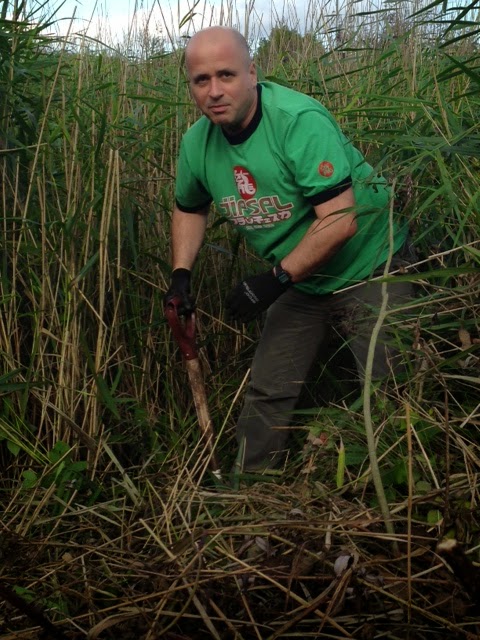Immediately following on the12th winter arrived with a jolt; flocks up to 150 pink footed geese heading over with the first 6 whooper swans on O res - Michael Flowers:
4 pintail had arrived on the 10th which join the ever present 5 red crested pochard on the D reservoir. There have been groups of 200 golden plover since the 9th. Redwing have been present in small numbers in North and South Scrub - but perhaps the big highlight has been short eared owl found by Michael Flowers on the 14th over Hempholme Meadow - picture by Michael:
Resonance of the great winter of 11/12 when we had 3 birds all winter - certainly it s been a good year for barn owls with voles everywhere so it's shaping up well. The Thursday gang are reasonably sure the bird was seen again on the 16th. Incidentally we now have Michael's East Yorkshire Wildlife calendars in stock art the Warden's base at £8 a time - more details as ever on his blog. Enjoying a vole bounty too were the kestrels which are active at the minute - Steve Brimble:
And stoat - Chris Bell:
Water voles are very active on North Pond and giving confiding views if you have never encountered one - Steve Brimble:
And Michael Flowers:
Also swimming about water rail on North Marsh by Steve Hines - up to 3 in the week on South Marsh West:

And Chris Bell - more pictures on his site here:
If you are lucky blackcap has been amongst them though goldcrest are an easier find - Michael Flowers:
Chris Bell:
The two young marsh harriers still continue to frequent the area - Steve Brimble:
And ever present Buzzard - Steve Brimble:
And kingfishers are making good of the mild conditions to give a continued shows on North Marsh; The first frosts will see them off 'til June so be quick Steve Brimble:Resident dog otter - looks like 'one eye' by Bruce Pillinger on North Marsh - a mother and cub were reported showing well in Hempholme Lock on Thursday last:
Roe deer in the mist- Chris Bell:
We've been doing a lot of work on North Marsh as part of our ongoing Higher Level Stewardship work. The aims are multiple with routes for the new stock fence being cleared along with scrub removal from the grassland and marshes; with the end result being to reclaim the established line of pollards - these older trees have been pollarded many times by successive wardens and volunteers and its our turn to have a go.Traditionally they would have been cut at height to prevent stock from browsing new growth out and the whippy regrowth used at various stages for stock feed, basket weaving and hurdles. The resultant dense re growth is brilliant for warblers and an array of fungi - this green elfcup being a cracking species on one.
For more info on fungi and hornets check out both Africa's and Guillermo's excellent blogs, pictures and artwork. We have practical gangs that venture out three days a week with spaces on Fridays and Sundays for more so if you fancy some fresh (smokey) air, excercise and good banter just get in touch. Lukas and Mike crossing the north marsh to manage willow on islands used by bittern and harriers:
Dragging back:
To the processing yard - Good fun as ever from a great team.:
We're not quite sure on the fate of this legless common gull by Brian Colley - fishing line being the main suspect:
Med gull and lesser black backed's being present on barmy October evenings so far - Steve Hines:




+chris+bell.jpg)
+chris+bell.jpg)







+chris+bell.jpg)




+chris+bell.jpg)






.jpg)























